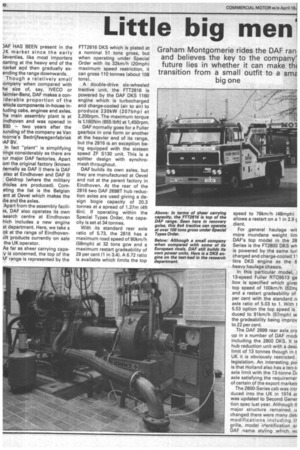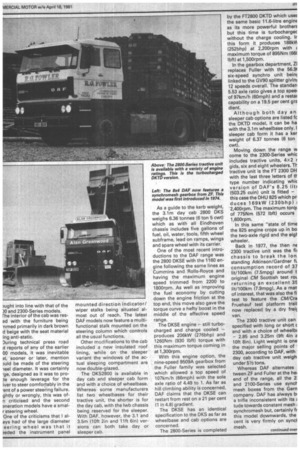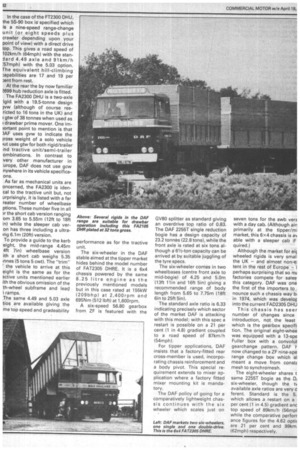Little big men'
Page 32

Page 33

Page 34

Page 35

If you've noticed an error in this article please click here to report it so we can fix it.
)AF HAS BEEN present in the JK market since the early ieventies, like most importers ;tarting at the heavy end of the narket aod then gradually exending the range downwards. Though a relatively small :ompany when compared with he size of, say, IVECO or )aimler-Benz, DAF makes a coniderable proportion of the ehicle components in-house inRiding cabs, engines and axles. he main assembly plant is at indhoven and was opened in 930 — two years after the )unding of the company as Van loorne's Bedrijfswagenfabriek rAF BV.
In fact "plant" is simplifying :iings considerably as there are iur major DAF factories. Apart om the original factory (known ternally as DAF I) there is DAF also at Eindhoven and DAF III Geldrop (where the military )hicles are produced). Corneting the list is the Belgian ant at Oevel which makes the ibs and the axles.
Apart from the assembly faciliDAF also operates its own ,search centre at Eindhoven hich includes a new engine st department. Here, we take a ok at the range of Eindhovenjilt products currently on sale the UK operator.
As far as sheer carrying cepa:y is concerned, the top of the %F range is represented by the FTT2816 DKS which is plated at a nominal 51 tons gross, but when operating under Special Order with its 32km/h (20mph) maximum speed restriction, it can gross 110 tonnes (about 108 tons).
A double-drive six-wheeled tractive unit, the FTT2816 is powered by the DAF DKS 1160 engine which is turbocharged and charge-cooled (air to air) to produce 230kW (207bhp) at 2,200rpm. The maximum torque is 1,160Nm (855 bft) at 1,450rpm.
DAF normally goes for a Fuller gearbox in one form or another at the heavier end of its range, but the 2816 is an exception being equipped with the sixteen speed ZF S130 unit. This is a splitter design with synchromesh throughout.
OAF builds its own axles, but they are manufactured at Oevel and not at the parent factory in Eindhoven. At the rear of the 2816 two DAF 2698T hub reduction axles are used giving a design bogie capacity of 20.3 tonnes at a spread of 1.37m (4ft 6in). If operating within the Special Types Order, the capacity is set at 34 tonnes.
With its standard rear axle ratio of 5.73, the 2816 has a maximum road speed of 90km/h (56mph) at 32 tons gcw and a maximum restart gradeability of 29 per cent (1 in 3.4). A 6.72 ratio is available which limits the top Above: in terms of sheer carrying capacity, the FTT2816 is top of the DAF range. Seen here in recovery guise, this 6x4 tractive can operate at over 100 tons gross under Special Types Order.
Below: Although a small company when compared with some of its European rivals, DAF still builds its own power units. Here is a DKS engine on the test-bed in the research department. speed to 76km/h (48mph) allows a restart on a 1 in 2.9 c dient.
For general haulage wit more mundane weight Urn DAF's top model in the 28 Series is the FT2800 DKS wh is powered by the same turl charged and charge-cooled 11 litre DKS engine as the 6 heavy haulage chassis.
In this particular model, 13-speed Fuller RT09513 ge box is specified which give,: top speed of 100km/h (62mi and a restart gradeability of per cent with the standard n axle ratio of 5.03 to 1. With t 5.53 option the top speed is duced to 91km/h (57mph) w the gradeability being improv to 22 per cent.
The DAF 2699 rear axle cro up in a number of DAF modi including the 2800 DKS. It is hub reduction unit with a desii limit of 13 tonnes though in t UK it is obviously restricted legislation. An interesting poi is that Holland also has a ten-ti axle limit with the 13-tonne D/ axle satisfying the requiremer of certain of the export market: The 2800-Series cab was intr duced into the UK in 1974 ar was updated to Second Gener tion spec last year. Although ti major structure remained u changed there were many deti modifications including a grille, model identification ar OAF name styling which wz
night into line with that of the )0 and 2300-Series models. Ihe interior of the cab was resed with the furniture being -rimed primarily in dark brown d beige with the seat material ing anti-static.
During technical press road 3t reports of any of the earlier 00 models, it was inevitable 3t, sooner or later, mention )uld be made of the steering leel diameter. It was certainly -ge, designed as it was to prole enough leverage for the iver to steer comfortably in the 'ent of a power steering failure. ghtly or wrongly, this was ofn criticised and the second 3neration models have a smalr steering wheel.
One of the criticisms that I alays had of the large diameter eering wheel was that it 3eded the instrument panel mounted direction indicator/ wiper stalks being situated almost out of reach. The latest DAF models now feature a multifunctional stalk mounted on the steering column which controls all the usual functions.
Other modifications to the cab included a new insulated roof lining, while on the sleeper variant the windows of the actual sleeping compartment are now double-glazed.
The DKS2800 is available in day cab and sleeper cab form and with a choice of wheelbase. Whereas some manufacturers list two wheelbases for their tractive unit, the shorter is for the day cab, with the iwb chassis being reserved for the sleeper. With OAF, however, the 3.1 and 3.5m (10ft 2in and lift 6in) versions can both take day or sleeper cab. As a guide to the kerb weight, the 3.1m day cab 2800 DKS weighs 6.36 tonnes (6 ton 5 cwt) which as with all Eindhoven chassis includes five gallons of fuel, oil, water, tools, fifth wheel subframe, lead on ramps, wings and spare wheel with its carrier.
One of the most recent introductions to the DAF range was the 2800 DKSE with the 1160 engine following the same lines as Cummins and Rolls-Royce and having the maximum engine speed trimmed from 2200 to 1800rpm. As well as improving the fuel economy by cutting down the engine friction at the top end, this move also gave the torque curve a hefty boost in the middle of the effective speed range.
The DKSE engine — still turbocharged and charge cooled — produces 206kW (276bhp) and 1260Nm (930 lbft) torque with this maximum torque coming in at 1,300rpm.
With this engine option, the nine-speed 9509A gearbox from the Fuller family was selected which allowed a top speed of 107km/h (66mph) with the sole axle ratio of 4.49 to 1. As far as hill climbing ability is concerned, DAF claims that the DKSE can restart from rest on a 21 per cent (1 in 4.8) gradient.
The DKSE has an identical specification to the DKS as far as wheelbase and cab options are concerned.
The 2800-Series is completed by the FT2800 DKTD which uses the same basic 11.6-litre enginE as its more powerful brothers but this time is turbochargec without the charge cooling. Ir this form it produces 188141 (252bhp) at 2,200rpm with s maximum torque of 895Nm {66( lbft) at 1,500rpm.
In the gearbox department, ZI replaces Fuller with the 56.91 six-speed synchro unit beim linked to the GV90 splitter givim 12 speeds overall. The standar( 5.53 axle ratio gives a top speel of 97km/h (60mph) and a restar capability on a 19.5 per cent gra dient.
Although both day an sleeper cab options are listed fc the DKTD model, it can be ha with the 3.1m wheelbase only. I sleeper cab form it has a ker weight of 6.37 tonnes (6 ton cwt).
Moving down the range w come to the 2300-Series whic includes tractive units, 4x2 r gids, six and eight wheelers. tractive unit is the FT 2300 DH with the last three letters of tltype number indicating whit version of DAF's 8.25 litr (503.25 cuin) unit is fitted — this case the DHU 825 which pr duces 1 6 9 kW (2 3 Obhp) '2,400rpm. The maximum torqt of 775Nm (572 lbft) occurs 1,60Orpm.
In this same "state of time the 825 engine crops up in bo the two-axle rigid and the eigt wheeler.
Back in 1977, the then ne 2300 tractive unit was the fil chassis to break the Ion standing Atkinson/Gardner fi consumption record of 37 lit/100km (7.5mpg) around t original CM Scottish test roi returning an excellent 35 lit/100km (7.9mpg). As a mat of interest, that was also the fi test to feature the CM/Cra Fruehauf test platform trail now replaced by a dry freic van.
The 2300 tractive unit can specified with long or short c and with a choice of wheelbr — 2.85 and 3.25m (9ft 4in a 10ft 8in). Light weight is one the major selling points of • 2300, according to DAF, with day cab tractive unit weigh under 51/2 tons.
Whereas OAF alternates tween ZF and Fuller at the he end of the range, all the 2: and 2100-Series use synct mesh boxes from the Gemn company. DAF has always lai a trifle inconsistent with its tude towards constant mesh ; synchromesh but, certainly fr this model downwards, the cent is very firmly on syncl
mesh. continued over
In the case of the FT2300 DHU, the 5S-90 box is' specified which is a nine-speed range-change unit (or eight speeds plus crawler depending upon your point of view) with a direct drive top, This gives a road speed of 102km/h (64mph) with the stenJard 4,49 axle and 91km/h :57mph) with the 5.03 option. The equivalent hill-climbing capabilities are 17 and 19 per cent from rest.
At the rear the by now familiar ?699 hub reduction axle is fitted.
The FA2300 DHU is a two-axle igid with a 19.5-tonne design jvw (although of course resrioted to 16 tons in the UK) and t gtw of 38 tonnes when used as drawbar prime mover, One irniortant point to mention is that )AF uses gvw to indicate the iross weight of a solo vehicle iut uses gtw for both rigid/trailer nd tractive unit/semi-trailer ombinations. In contrast to very other manufacturer in urope, DAF does not use gcw nywhere in its vehicle specificaons.
As far as mechanical units are oncerned, the FA2300 is idencal to the tractive unit but, not arprisingly, it is listed with a far reater number of wheelbase ptions. These number five in all )1the short cab version ranging om 3.65 to 5.55m (12ft to 18ft in) while the sleeper cab veron has three including a ultraing 6.1m (20ft) version.
To provide a guide to the kerb eight, the mid-range 4.45m 4ft 7in) wheelbase version ith a short cab weighs 5.35 .nnes (5 tons 5 cwt). The "trim" the vehicle to arrive at this eight is the same as for the active units mentioned earlier ith the obvious omission of the th-wheel subframe and lead ramps.
The same 4.49 and 5.03 axle tios are available giving the me top speed and gradeability performance as for the tractive unit.
The six-wheeler in the DAF stable aimed at the tipper market hides behind the model number of FAT2305 DHRE. It is a 6x4 chassis powered by the same 8.25 litre engine as the previously mentioned models but in this case rated at 155kW (209bhp) at 2,400rpm and 695Nm (512 lbft) at 1,600rpm.
A six-speed 56.80 gearbox from ZF is featured with the GV80 splitter as standard giving an overdrive top ratio of 0.83. The DAF 2255T single reduction bogie has a design capacity of 23.2 tonnes 122.8 tons), while the front axle is rated at six tons although a 61/2-ton capacity can be arrived at by suitable juggling of the tyre specs.
The six-wheeler comes in two wheelbases (centre front axle to mid-bogie) of 4.25 and 5.0m (13ft 11in and 16ft bin) giving a recommended range of body length from 5.65 to 7.75m (18ft 6in to 25ft bin).
The standard axle ratio is 6.33 indicating precisely which sector of the market DAF is attacking with this model: with this spec a restart is possible on a 21 per cent 11 in 4.8) gradient coupled to a road speed of 87km/h (54mph).
For tipper applications, DAF insists that a factory-fitted rear cross-member is used, incorporating chassis reinforcement and a body pivot. This special requirement extends to mixer application where a factory fitted mixer mounting kit is mandatory.
The DAF policy of going for a comparatively lightweight chassis continues with the six wheeler which scales just on seven tons for the swb ver5 with a day cab. (Although air primarily at the tipper/mi market, this 6x4 chassis is av able with a sleeper cab if quired.) Although the market for eic wheeled rigids is very smal the UK — and almost non-e: tent in the rest of Europe — i perhaps surprising that so mi factories compete for sales this category. DAF was one the first of the importers to nounce such a chassis way in 1974, which was develor into the current FAD2305 DHU This chassis has seer number of changes since introduction, not the least which is the gearbox speciff tion. The original eight-whee was equipped with a 13-spe Fuller box with a convolut gearchange pattern. DAF now changed to a ZF nine-spe range change box which al meant a move from consU mesh to synchromesh.
The eight-wheeler shares t same 2255T bogie as the D, six-wheeler, though the t‘, available axle ratios are very e ferent. Standard is the 5. which allows ra restart on a per cent (1 in 4.5) gradient anc top speed of 89km/h (56mp1 while the comparative perforr ance figures for the 4.62 optic are 21 per cent and 99km (62mph) respectively.
kF can build the 8x4 in two elbases; 5.65 and 6.25m 6in and 20ft Sin). Although ieper cab option is available, n only be specified with the er version. Taking the Iwb ;sis in particular, DAF claims
a body length of over 28ft be catered for, ithin the confines of the 30UK weight limit, the chassis weight (swb version) of 8,35 les (8 tons 2 cwt) gives rty of payload scope even in the weight of bodywork/ ing gear and so on is taken account.
)r the operator who wants a Nheeler for on-road rather on-site, DAF offers the 32205 DHR which uses ther variant on the well-tried 8.25-litre engine theme. The 3 version is again turborged, but at this rating it pro:es 150kW (202 bhp) at Mrpm with a maximum torof 670Nm (494 lbft) at Mrpm.
line with DAF thinking for sector of the market, the sixed synchromesh S6.65 box is :ured complete with splitter t which gives a top speed of : under the 60mph mark with the optional 5.72 axle and 86km/h (54mph) with the standard 6.33 ratio.
Plated for 24 tons solo and 32 tons gtw (the European definition), the FAS2105 includes trailer brake and electrical connections among its list of factory-fitted options.
The same DHR engine also crops up in the FT2105 4x2 rigid and tractive unit variants whereas the FA 2105 uses the DH rating. Unique among DAFs in the UK in that it is the only naturally aspirated engine in the range, the DH825 produces 117kW (156bhp) with a peak torque of 505Nm (372 lbft).
Though both the DHR and OHengined chassis in the 2100Series are suitable for 16-ton operation as solo rigids, the DH is plated for 26 tons as a drawbar prime mover.
The FA2105 OH is available with a selection of wheelbases ranging from 4m (13ft 1in) to
6.1m (20ft), though the latter i only listed with the sleeper cat The longest wheelbase in th day cab chassis is 5.55m (18 3in) which has a kerb weight 5.28 tonnes (5 tons 4 cwt).
With three axle ratios lisle( the DH-engined chassis ca have a top speed of 97km/ (60mph) or a gradeability of per cent depending on inc vidual operator requirements.
In common with Scania ar Volvo but in contrast to Daimle Benz and IVECO, DAF comes f, far down the weight range ar no further. The "bottom" of tl Dutch company's range in tt UK is represented by the 161 models with the FT1600 tracti' unit and the FA1600 rigid.
The former is intended f operation at around 24 tor whereas the rigid is designed f 12.7 tons gvw or 24.8 tons aE drawbar combination.
Both are powered by the sm lest DAF engine offered in t UK, the turbocharged DT615 6.17 litres (376cuin) capac which delivers 114kW (155bt at 2,400rpm.
DAF has been particula successful in this country o■ the past few years, not only reasons of technical specifi tion but also for being seen "try harder" if I can borrow Avis phrase.
DAF Trucks (GB) Ltd is stil relatively small operation wt. compared with some of its a tinental rivals and this will h the key to the company's fut — whether DAF, as it expan can successfuly make the trai tion from being a big small cc pany to a small big one.




















































































